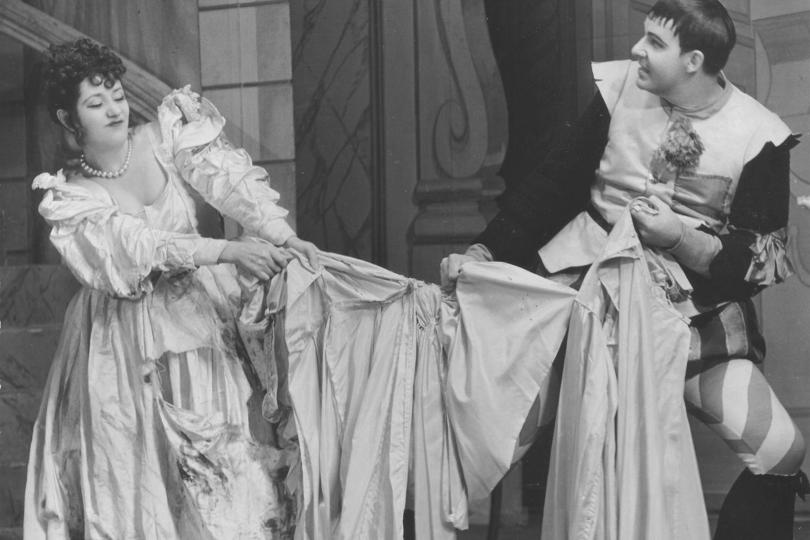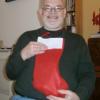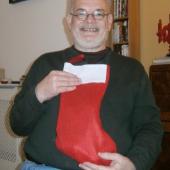Alfred Lunt and Lynn Fontanne

Many of you have never heard of them, but Alfred Lunt and Lynn Fontanne were, quite simply, the greatest acting couple of the 20th Century. In a career that spanned five decades, they were the last actor-manager company to tour. Their legacy lives on, however, both in New York and in a Wisconsin village.
Alfred Lunt (1882-1977), (he was always billed first), was born in Milwaukee, WI. Lunt attended Carroll College, but as an ambitious young man, he once passed a Boston theater, went in and asked for a job. He was paid $5 a week and that’s basically how he got his start as a paid actor. In 1919, Booth Tarkington took one look at the 6’2” Lunt and cast him in Clarence, which made him a star.
Lynn Fontanne (1887-1983) was British and had worked with the great Ellen Terry, but came to America with Laurette Taylor’s Company. (Taylor would create the role of Amanda Wingfield in The Glass Menagerie.) She reached stardom when she appeared in George S. Kaufman and Marc Connelly’s comedy, Dulcy. Lunt and Fontanne were married in 1921, but in 1928, as members of the Theater Guild, they decided to only act together. They did for the rest of their careers.
The Guardsman
The Lunts’ first success was Ferenc Molnar’s The Guardsman. This Viennese comedy about an actor, who believes his wife is cheating, only to learn otherwise became their signature piece. They later filmed it at MGM, and received Oscar nominations, but when offered a longer film contract, Miss Fontanne told them “We can be bought but we can’t be bored.”
Stage Appearances
On Broadway, in London and on tour, Alfred Lunt and Lynn Fontanne performed in 27 productions, among them Maxwell Anderson’s Elizabeth the Queen, Jean Giraudoux’s Amphitryon 38, Chekhov’s The Sea Gull and Shakespeare’s The Taming of the Shrew. It was during a performance of Shrew that the couple was having an offstage argument that they didn’t take onstage with them. Their spat became the basic plot for Cole Porters’ Kiss Me, Kate, and in the musical the leading characters are named Fred (as in Alfred) and Lilli (which is Fontanne’s real first name). Robert E. Sherwood wrote three plays for them, including his two Pulitzer Prize winners, Idiot’s Delight (to be presented at Park Square this summer) and There Shall Be No Night.
The Lunts’ acting style was significant, because they’d develop a rhythm and overlap lines as they created characters that would become truly memorable. It’s said they made even the worst script playable, but even when they did vehicles unworthy of their talents, audiences loved them. (They were even parodied by Carol Burnett and Harvey Korman as Funt and Mundane).
Friends
Among their closest friends was Noel Coward, who wrote Design for Living for the three of them to act together. Because of its themes of bisexuality and a ménage a trois, the production premiered on Broadway rather than risk the censors in London. Frugal but generous to their friends and colleagues, besides Coward (who would write two more plays for them), these included Sidney Greenstreet (Casablanca), Juanita Hall (South Pacific) and Dick van Patten (Eight is Enough). They were so fond of Montgomery Clift, who played their son in There Shall Be No Night, that they described themselves as “your real parents;” Carol Channing listened when Miss Fontanne told her: “it’s your duty to tour the Provinces,” logging over 5,000 performances as Dolly Levi, mostly on tour. Following her work with the Lunts in The Sea Gull, in addition to acting, Uta Hagen (she would create the role of Martha in Who’s Afraid of Virginia Woolf?) learned that she had a knack for teaching and with Herbert Berghof, whom she later married, created the HB Studios.
In the mid-1940s, actors volunteered at the Stage Door Canteen, located near Sardi’s on W. 44th Street. Here soldiers from the allied forces could dance with showgirls and have food served by the stars of Broadway shows including the Lunts. RKO released an all-star film, the profits which helped fund the Canteen via the American Theater Wing. Celebrity appearances are brief, Lunt tells an aspiring actor to “work this trash can straight up to Shubert Alley,” while Fontanne is pleased when a soldier gushes over her recording of “The White Cliffs of Dover.”
Ten Chimneys.org
The Lunts spent their summers in Wisconsin, where they gardened, hosted friends and prepared for the following season’s play. Lunt bought the land in Genesee Depot for his mother. Gradually “Ten Chimneys” as it became known, grew to over 150 acres, and included a studio, creamery, barn and a chicken coop that was transformed into a Swedish cottage. A visit to the estate brings their theatrical history to vivid life. Every room of the house is designed like a stage setting. There’s the Flirtation Room, a well-stacked Library, a living room decorated in Bible scenes and featuring a piano, painted white and decorated to please Coward. Lunt bought the contents of David Belasco’s office. The furniture, upholstered in yellow taffeta, includes the first “casting couch.”
Upstairs, the master bedroom features Fontanne’s dress mannequin (she was an accomplished seamstress) and the dressing table facing a window from which she could see arrivals and make a star’s entrance. Helen Hayes and Noel Coward had their own bedrooms. When the couple first married, they bought a three-quarter bed. When it was brought to Wisconsin, it was installed in the Olivier Room. (Olivier was almost as tall as Lunt.)
The dining room is decorated with zodiac designs, and standing in this elegant room, the presence of the Lunts is felt as we imagine them formally dressed and enjoying the meals that came from the well-equipped kitchen. Lunt was a gourmet chef who was a graduate from the Cordon Bleu.
The staff at Ten Chimneys delighted when the rotund Alexander Woollcott would visit, because he’d dress in an orange wrapper and sit on the porch of the Swedish cottage, resembling a large pumpkin. However, one of the staff quit when, after swimming, Coward walked through the kitchen in the nude.
Ten Chimneys is open for tours Tuesdays through Sundays from April until early December. A visit to this extraordinary place should make anyone in theater wish they had known Lunt and Fontanne.
The Visit and Retirement
By the late 1950s, the Lunts faced health issues, so they searched for an exciting vehicle in which to make their final appearance. They selected Friedrich Durrenmatt’s The Visit. This astounding drama tells of a wealthy widow who returns to her desolate hometown with a request. She will help them financially if they kill the storekeeper who ruined her adolescence. Under the guidance of British director Peter Brook, the play first toured the UK provinces. Producer Roger Stevens bought the Globe Theater, which he had renovated. Decorated with photographs from their career it was renamed the Lunt-Fontanne.
The Lunts never officially retired. They continued to perform when the opportunity arose. Their production of The Great Sebastians was remade for television, and in 1965, they played Oliver Wendell and Fanny Holmes in the Hallmark Hall of Fame production of The Magnificent Yankee.
In 1964, President Johnson presented the Lunts with the Presidential Medal of Freedom and in 1970, they were given honorary Tony Awards. One of their last appearances was with Noel Coward as they were interviewed by Dick Cavett. Lynn Fontanne was also given a Kennedy Center Honor in 1980.
Alfred Lunt died from cancer in Chicago, just nine days before his 85th birthday and became the third person for whom the lights of all Broadway theaters were dimmed. Lynn Fontanne died in 1983 at age 95 at Ten Chimneys. They are buried at the Forest Home Cemetery in Milwaukee.
Because the Lunts were so important to the American Theater, in addition to watching them in The Guardsman and Stage Door Canteen, people will learn more about them by reading The Fabulous Lunts by Jared Brown (Forward by Helen Hayes) link: www.amazon.com/Fabulous-Lunts-Biography-Alfred-Fontanne/dp/1420854704; Design for Living by Margot Peters; and the delightful Alfred Lunt’s Cookbook. The Cookbook features many of Lunts’ tried and true recipes including his famous Cardamom Bread, and more. Peppered with photographs from Ten Chimneys, this is a genuine treat!
On your To Do List for this summer, include a visit to Genesee Depot and Ten Chimneys!




